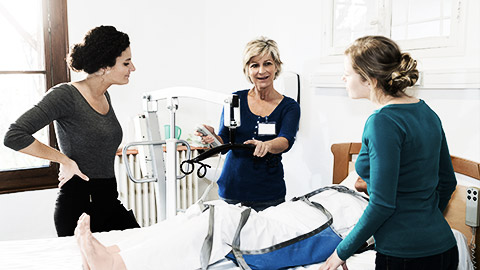Consultation means that all members of the workforce take responsibility for discussion and making changes to processes that affect their own safety. Consultation can include meetings, discussions, training and self-reflection. Reflection on your own, in discussion with colleagues or health and safety meetings, can help you to think about challenges, propose solutions and help each other to improve safety through shared learning about what you could do more safely.
By the end of this topic, you will understand:
- Ways to maintain currency of safe work practices through training and consultation
- How to reflect on your own levels of stress and fatigue and report to designated persons according to workplace procedures
- The process of participating in workplace meetings and debriefing

WorkSafe practices change often. All workers must maintain currency in understanding how to follow processes and use equipment.
WHS Meetings
Regular WHS meetings should be a forum to discuss health and safety issues.
You can raise issues such as:
- Problems that you or other staff might be having with understanding or complying with the policy
- Instances where policies are being breached and how this could be overcome. Your managers or WHS representative can help you to learn and understand new things about safety issues, such as:
- Changes to the workplace or to WHS policies or procedures
- Informing you about updates to health and safety legislation
- Providing support and guidance to help you adhere to the policy.
Reflecting on Safety Practices
Be honest, open and non-defensive in asking for and receiving feedback from others. Keeping a journal is one way to use critical thinking about your own performance. Alternatively, you might ask yourself a series of questions after an experience related to health and safety that could be improved. You and others need to reflect on near misses or on situations that have caused harm.
Here is good example of managing incidents at workplace How do you Manage an exposure incident
What an exposure incident is? Workplace exposures occur when members work with or around chemical, biological, and physical hazards that can lead to an acute or chronic illness, and even death. An exposure incident is defined as specific eye, mouth, other mucous membrane, non-intact skin or parenteral contact with blood or potentially infectious materials. Organizational policies and procedures you must follow when you are exposure incident occurs: •When an exposure incident occurs, immediate action must be taken to expedite medical treatment for the exposed employee and to assure compliance with the Standard. immediate decontamination of the exposed area and treatment of any wounds must take place. •immediate reporting of the exposure to the supervisor, manager or designated responsible person such as first aid officer must be done. •immediate assessment of the risk of transmission of infection must take place. The organisation may choose to refer the exposed person to an occupational health specialist or transfer them to a hospital emergency department for this assessment and counselling. •prompt treatment if indicated, eg post-exposure prophylaxis against a known or suspected blood-borne virus, tetanus vaccination or immunoglobulin, as required. If the exposed person is referred for assessment, treatment is administered or arranged by the hospital or consulting physician. (Post-exposure prophylaxis is not delayed while waiting for results of testing of the source person, but is administered immediately when indicated on the basis of the assessment. parties to whom it should be reported to manage exposure incidents: •supervisor – Immediately as you have been exposed to incident •general practitioner – Employee or supervisor must contact a GP for exposure prone disease or infection that an employee may be exposed to. A description of the exposed employee’s duties as they relate to the exposure incident. (Accidental Bodily Fluid Exposure Form),Documentation of the route(s) of exposure and circumstances under which exposure occurred. (Accidental Bodily Fluid Exposure Form). All medical records relevant to the appropriate treatment of the employee including HBV vaccination status records and source individual’s HBV/HCV/HIV status, if known. •health care professional - Evaluate the exposure incident and arrange for testing of employee and source individual (if status is not already known). Notify the employee of results of all testing. Provide counseling and post-exposure, evaluate reported illnesses. Send written opinion to the employee including further treatment requirements post exposure. •carer - Implementation of various methods of exposure control, including: Universal precautions Engineering and work practice controls Personal protective equipment Housekeeping •responsible person – this would be based on the level of exposure. The immediate person to report is supervisor and based on exposure incident and infection involved it would need to be further reported to health care professionals, GP ect. •responsible authority- This would be based on the level of exposure. If the exposure is life threatening, then this would involve relevant health authorities and police in many cases.
Questions for reflection might include:
- What happened in this situation?
- Did my or our actions possibly contribute to that outcome?
- Did I or we meet legal and ethical requirements, including the following policy?
- What could I or we have done better, or how could I or we act differently in future when faced with the same or similar situation?
- Where can I go to learn more about improving my knowledge or approach so that I can improve the safety of myself and others?
Discussing and Improving Safe Work Practices and Contributing to Policy Change
All members of the workplace should be included in updating, reviewing and altering policies. The first part of this process is to seek feedback on how the policy is currently working, using the methods described above. Other sources of feedback that can influence policy include looking closely at incident and illness statistics, near-miss reports and the results of risk assessments. It can also mean watching how procedures are currently performed and asking for feedback on safer procedures.
The policy committee must then ensure that the policy meets current legislation. Any change to a policy must be done in consultation with the people who are affected by it. A draft form of the policy should be put to staff for feedback before it is written in its final form.
You can contribute to policies with ideas and feedback at any time in the review cycle. For example:
- Submit a suggestion for non-urgent improvement to the policy committee so that your suggestion can be considered the next time the policy is reviewed
- Bring feedback or a suggested change to a staff meeting
- Put your idea for improvement into writing and provide it to managers via email, mail or a suggestion box.

You must complete certain types of training regularly for your service to maintain its accreditation. The frequency and type of training you undertake depends on the type of service you work in. It can include:
- First aid certificate, including CPR
- Infection control
- Manual handling and safe use of equipment
- Fire safety and emergency evacuation training
- Emergency evacuation drills
- Asthma and anaphylaxis training
- Identifying and responding to abuse.
It is your responsibility to inform your manager if you feel that you are inadequately trained for a specific task or if you feel that you could benefit from additional training.
Your service must keep up-to-date records of staff who have attended compulsory training, along with records of other non-compulsory professional development. These are a crucial part of accreditation assessments.
Personal care practices as part of health and wellbeing when working in various different circumstances You have been doing long hours shifts supporting many sick clients. Here are six personal hygiene practices to use and wear clean clothing and uniforms.
1)Wear gowns and other personal protective equipment over the uniform while caring for patients who may have infections to reduce the chance of spreading germs from patients or items in their environment to other patients or environments.
2)Change clothes early and often. If you're a frontline health worker or have likely come into contact with the virus during your day, then change clothes as soon as possible or at least as soon as you get home, and treat what you were wearing as you would other contaminated clothing. This minimises your exposure if your clothes do happen to have the virus on them.
3)Wash uniforms and other clothing worn to work daily in hot water and laundry detergent, or with cold water and bleach.
4)Drying clothes completely in a hot dryer, rather than air-drying, to kill bacteria in clothes.
5)Ensuring to not mix soiled uniforms with other personal clothing.
6)If the uniforms are contaminated or soiled change them immediately putting on fresh new uniform and disgarding the contaminated uniform as per organisational policies and procedures for example putting the contaminated uniform in a separate labelled bucket. Steps to follow for managing and laundering of work clothes after your work shift.
1)Store contaminated laundry separately
2)Do not shake out contaminated laundry – it can release viruses and other germs into the air. Carry contaminated clothing carefully and load your washing machine gently.
3)Wash contaminated clothing in hot water – ideally 60°C or above (provided it won't damage the fabric) – and use a bleach-containing detergent, or if washing whites, then add bleach to the wash itself (following the manufacturer's recommendation) for the best virus-destroying performance.
4)Once the laundry's on, clean and sanitise any surfaces you've had contact with in the course of doing the laundry using bleach or household disinfectant. This includes the door and control panel of your washing machine, the laundry doorknob, and of course the hamper you've kept contaminated clothing in (and throw the hamper liner in with the wash too, if it's reusable).
5)Viruses spread more easily via wet surfaces than dry ones, so make sure your laundry's completely dry after washing to minimise the risk of contamination. What happens when you are sick/ill important way to reduce the spread of flu is to keep sick people away from those who are not sick. Therefore, if its flu like symptoms one should stay home and not come to work. The best way to manage this is to contact the supervisor inform them about your condition and stay at home till the symptoms subside and you are fit to be back at work again. Safe respiratory and cough etiquette you should follow to avoid the spread of infection
1. Cover your mouth and nose with a tissue when coughing or sneezing;
2. If you don't have a tissue, cough or sneeze into your elbow;
3. Use the nearest waste receptacle to dispose of the tissue after use;
4. Perform hand hygiene (e.g. hand washing with soap and water, alcohol-based hand rub, or antiseptic hand wash) after having contact with respiratory secretions and contaminated objects/materials.
5. Wear a mask with ear loops or a surgical mask with ties during periods of increased community respiratory illness such as influenza season.
Activity
Research and explore the following resources and answer questions below:
Explore these websites for examples of short training courses that are available on various WHS topics:
- WorkSafe Victoria ‘Health and Safety Representative Training’
- Fire & Safety Australia ‘Health & Safety Representative Courses’
- Compulsory Staff Education and Training Read the training and professional development policy for The Society of Saint Hilarion Inc. Aged Care: ‘Training (Professional Development)
- What training is compulsory for all staff?
- How often must this training be attended?
- How are training records kept?

Working in an environment with frail older people, people with dementia, or cognitive disabilities can be stressful and sometimes upsetting. It can also be a busy and physically challenging role, with a need to complete tasks thoroughly and completely. These factors can lead to stress, anxiety and emotional and physical fatigue.
Recognising the Signs of Stress
We all react differently to stress. It is important to get to know your small, early signs that might tell you that you are feeling stressed so that you can address these feelings before they become worse.
Here are some of the signs that you might see or feel:
Physical signs:
- Tense muscles
- Headaches
- Low energy
- Trouble sleeping
Emotional signs:
- Moodiness
- Depression
- Anxiety
- Overusing alcohol or drugs
- Forgetfulness
Strategies for Managing Stress
Practising self-care is essential for all aged care and disability services workers. This means taking regular time for yourself and doing activities outside of work that you enjoy, that make you feel better and that makes you feel better about yourself.
This can include:
- Physical activity and exercise
- Using meditation and relaxation techniques
- Listening to music
- Having a healthy balanced diet
- Getting enough sleep
- Participating in social activities and staying connected to friends and family.
If stress related to your work is building to a level that makes you feel concerned or uncomfortable or impacts your life outside of work, it is a good idea to talk to a manager about what factors in the workplace might be contributing. When you feel able to talk through concerns and differences of opinion respectfully—and when you are appreciated for the work you do—you are likely to be safer from the effects of stress. Your manager can often help you by giving reassurance about your work, reducing unequal or unrealistic workloads, or even helping you to learn new ways to manage your work and time. If this does not help, or if you prefer not to talk to a manager, many workplaces provide free access to confidential counselling services. Alternatively, you may wish to see a GP who can refer you to government subsidised psychology sessions.

Debriefing After an Emergency
A debriefing session following a major incident such as a preventable staff injury, a fire or other emergency can help all staff to talk through their emotions, practical strategies for coping and discussing what could have been done differently in a non-threatening and no-blame environment. An Employee Assistance Program should also be used to help with individual counselling.
The standardised debrief flow consists of the following four-step procedure:
- Re-state the objectives
- This will frame the debrief and draw attention to the specific intent of the session. The objectives, (which would have been developed during the planning cycle) should all be Specific, Measurable, Achievable, Realistic and Time bound, and should not be a surprise to anyone in the team.
- Determine the facts of what happened
- The facilitator will next identify what really happened during execution. This needs to be done efficiently without emotion and without anybody hiding behind their rank or position in the team. This is not the time for excuses or reasons for why things occurred, but to simply state the facts.
- Compare the outcome to the plan
- With the facts on the table, the team next compares what actually happened to what was supposed to happen (in accordance with the plan). When there is a difference between the outcome and the plan, then that becomes a ‘Focus Point’. It is important to identify the complete list of ‘Focus Points’ prior to analysing them because it is often the case that one focus point is caused by another focus point. It becomes frustratingly inefficient when the core ‘Focus Point’ is ignored and the resultant ‘Focus Points’ are debriefed to death!
- Debrief the focus points
- As alluded to in the previous paragraph, always start the process with the core ‘Focus Points’. Generally speaking there are only one or two of these that resulted in all of the issues.
Each ‘focus point’ will almost always fall under one of three broad categories – they being:
- Briefing – or poor communication: Team members were unaware of specific requirements required to achieve their task;
- Execution – Failure to follow standard or expected procedure; or
- Plan – the standard procedures are insufficient or incorrect.
Each Focus point must include a clearly stated ‘FIX’. This is a tangible piece of information, procedure or practice that the team will commit to implementing in the future.
At the conclusion of the debrief, the facilitator or leader of the group must ensure that the session concludes on a positive note.
Debriefs are the perfect vehicle for leaders to ‘lead by example’ and admitting mistakes and taking on board suggestions and feedback provided by more junior members of the team. Additionally, the debrief is an ideal location for the more experienced team members to share information and coach the more junior members of the team in a positive environment. Organisations that successfully implement regular debriefing sessions into their workplace report impressive outcomes both in actual performance and in employee satisfaction.
Discussions raised in a debriefing can include:
- What happened during the situation?
- What did we do well?
- What could we have done differently?
- What have we learnt or experienced that could help us to deal with that situation better next time?
- How can we get help if we are feeling strong emotional reactions to the event?
Case study on debriefing after an emergency
Liliane was threatened by a client with a severe mental illness at the doorway of the service. He was aggressive and abused her with names and insults. He told her that the government are out to get him and that they are doing whatever they can to cause him trouble. He refused to allow her to move, cornering her up against the wall. She told the man that she is sorry that the government are doing this to him. She asked if she could make a call, but he realised that she wanted to call the police, and he refused to move. Liliane remained calm. She nodded and agreed with the man, ‘I’m so sorry that you are in this situation,’ she told him. One of the other workers, Paula, noticed the client yelling at Liliane. She alerted the other staff, and together they evacuated the other clients into a safe back room, locking the door, while Paula called the police. Police arrived a few minutes later, and the man was taken away. Liliane was shaken but relieved. The workers were invited to attend a debrief the next day. Their manager praised Lilianne and the other staff for their actions. She helped them to talk about how the incident played out, how they each responded and what could have been done differently to avoid the incident from happening. The manager asks how each worker is feeling now, and whether she or senior management could be of more help. They discuss a duress alarm being provided at the front entrance, and the staff agree that this would give them additional reassurance. Liliane is offered individual counselling, and she agrees to this.
Lets do a quick knowledge check by completing the quiz below, before you proceed further.

